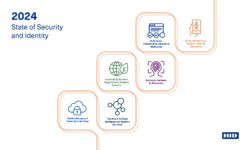Border Control Biometrics Revenues to Reach $3.5B by 2025: ABI Research
Camera shipment revenues for border control are forecast to reach $1.9 billion by 2025 due to adoption of video analytics and machine vision technologies.

Demands for higher levels of security, authentication and passenger processing speed in border control have caused ID to evolve rapidly, forcing an influx of new biometrics technologies, ABI Research says.
LONDON — Border control deployments of biometric kiosks, e-gates, video surveillance cameras and fingerprint, iris and face recognition devices will combine to create total revenues of $3.5 billion by 2025, according to global tech market advisory firm, ABI Research.
The demands for higher levels of security, authentication and passenger processing speed in border control have caused identity management to evolve rapidly, forcing an influx of new biometric technologies.
“Not only are these new technologies bringing forth a wide spectrum of monetization strategies for service integrators and stakeholders, they also are creating a new set of challenges,” explains Dimitrios Pavlakis, an industry analyst at ABI Research.
Border control authorities are heavily investing in biometrically enhanced authentication and security measures. These investments are increasing return on investment (ROI) and helping stakeholders develop better-honed monetization strategies. These include streamlining identity management and passenger flow, decreasing processing time, automating passenger authentication, improving the overall experience, and developing new interoperable platforms and services.
“However, this is predicated on the assumption that new infrastructure investments for Automated Border Control (ABC) management, new devices, and software services will be in place. ABC is greatly dependent upon biometric e-gates and passenger registration self-service kiosks using face, fingerprint, and iris recognition,” Pavlakis says.
New biometric hardware devices like handheld, immigration ID/authentication biometric device add-ons, access control and workforce management have also found their way into border control. Total revenues of biometric devices as well as e-gates, kiosks will reach $1.6 billion by 2025, including passenger registration and authentication, immigration, access control and workforce management.
Additionally, new biometric services allow governments and law enforcement to cooperate with international agencies through shared interoperable platforms and enhance their surveillance and counter-terrorism operation intelligence options across all land, air, and sea borders.
Global surveillance camera shipment revenues for border control will reach $1.9 billion by 2025 due to the push to strengthen border security via new video analytics, behavioral analytics, machine learning and machine vision technologies.
New challenges around infrastructure upgrades, technology adoption, and interoperability have arisen, which may create additional hurdles for stakeholders and hinder future projects.
“Integrating biometrics into border control is not an easy task — at least not if one is planning on maximizing their ROI,” Pavlakis says.
While biometric technologies are currently enjoying an increased penetration rate, border authorities and stakeholders must balance several conflicting variables. “These variables include supporting law enforcement, balancing biometric surveillance operations and interoperable services, decreasing operational latency, automating authentication, and streamlining passenger flow. All while complying with governmental mandates, regulations, data protection standards, and dealing with infrastructure upgrades and cybersecurity investments,” Pavlakis adds.
Biometric vendors and service integrators should take these challenges head-on, revisit the border control value chain, and customize their biometrics-as-a-service monetization strategies based on stakeholders’ ROI demands, expansion plans, and infrastructure requirements.
“Specialization is a key prerequisite, and innovative companies like Gemalto [Thales Group], IDEMIA, Collins Airspace, Gunnebo, Vision Box, Dermalog, HID Global and Aware each are developing their own unique market strategy by targeting different applications like e-gate and kiosk solutions, face/fingerprint/iris recognition hardware options, passenger management authentication, consumer and mobile biometric solutions, inter-agency data sharing, and interoperable service platforms,” Pavlakis concludes.
These findings are from ABI Research’s Biometrics in Border Control application analysis report.
If you enjoyed this article and want to receive more valuable industry content like this, click here to sign up for our FREE digital newsletters!

Security Is Our Business, Too
For professionals who recommend, buy and install all types of electronic security equipment, a free subscription to Commercial Integrator + Security Sales & Integration is like having a consultant on call. You’ll find an ideal balance of technology and business coverage, with installation tips and techniques for products and updates on how to add to your bottom line.
A FREE subscription to the top resource for security and integration industry will prove to be invaluable.







